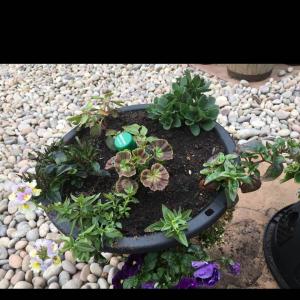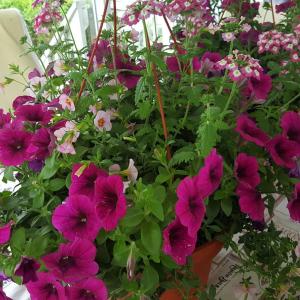求助
Ueca
2017年06月05日

What kind of flower is this? The petals are symmetrical down the centre of the flower and there is one tendril hanging out the back of each flower. The leaves are dark red underneath.
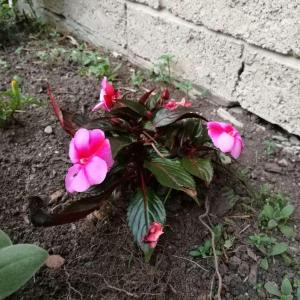
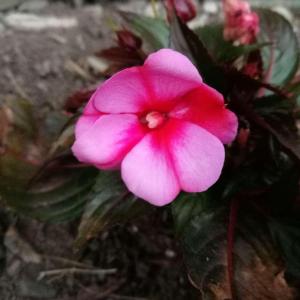


0
0
Trinity Rangel:I believe this is a impatiens Walleriana
文章
Gina
2017年05月25日

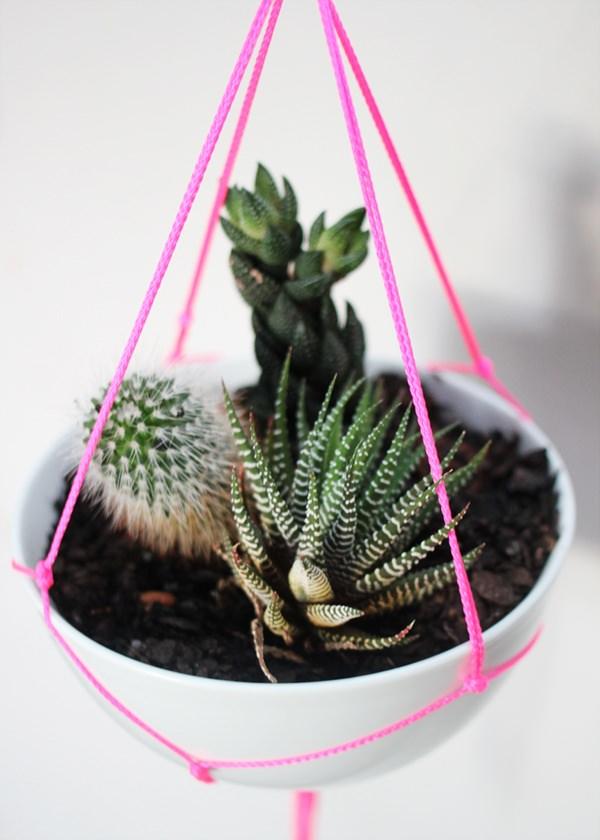
#Hanging planters work both indoors and out, with garden annuals and with evergreens. Creating your own DIY hanging planters is easy, and it adds character to your home or garden by giving you a unique container. Keep in mind that hanging planters can be heavy, so please use your judgement in choosing hanging materials, and in securing them to a structure. Other than that, anything that holds soil and is light enough to hang is fair game! Here are some DIY tutorials, inspirational photos and ideas to get you started. You can find the instructions for our featured project, above, at Drifter and the Gypsy.
This re-cycled hanging container idea is an easy one to figure out… glue pop container lids on, dip into paint and let dry, then punch holes (I bet a hole punch would work!) and hang with twine.
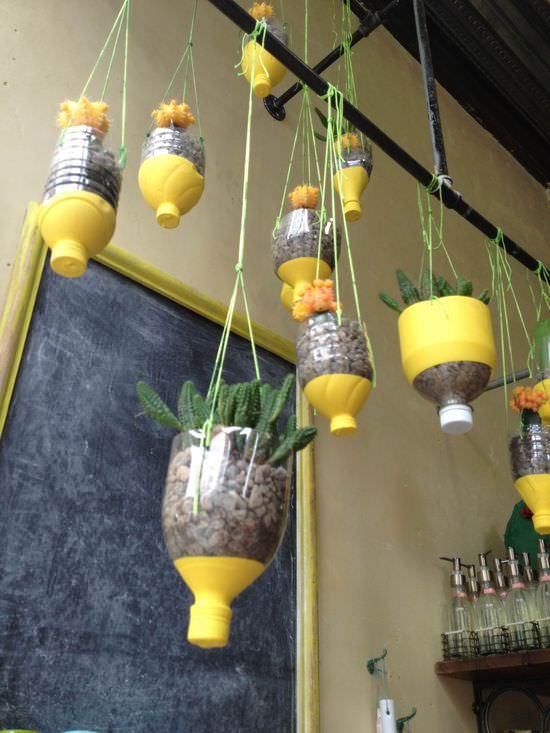
If you loved our post on garden lighting using insulators, you’re going to love this hanging planter. Pretty simple!
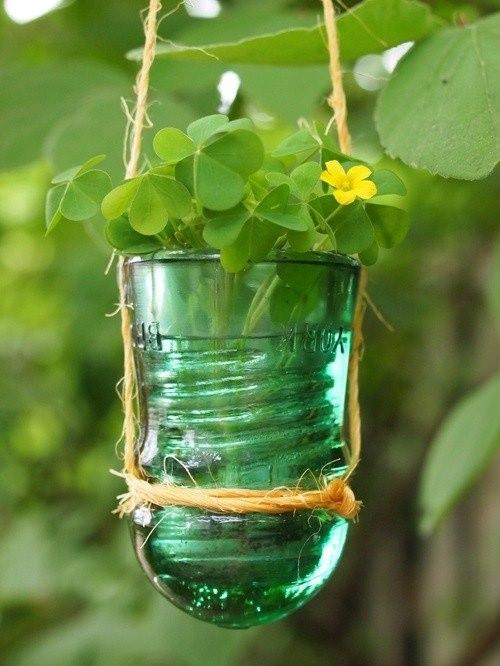
Eclectic Trends offers us this great tutorial on making this contemporary hanging planter with copper pipe and wire. Love the creativity!
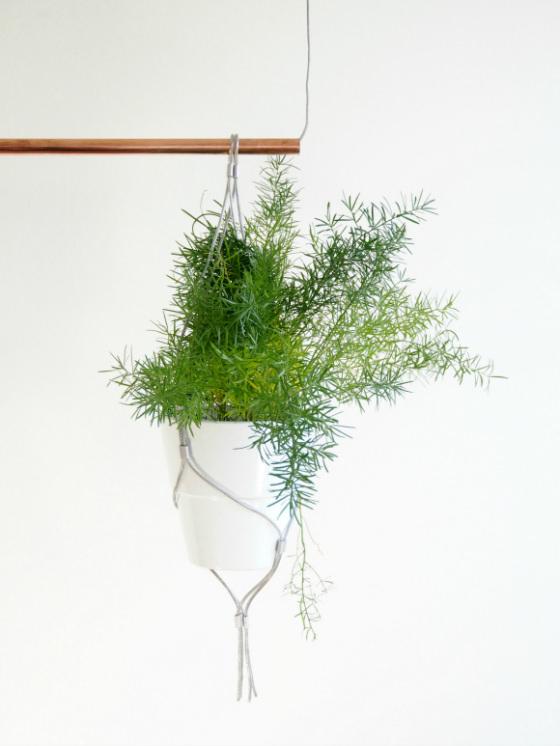
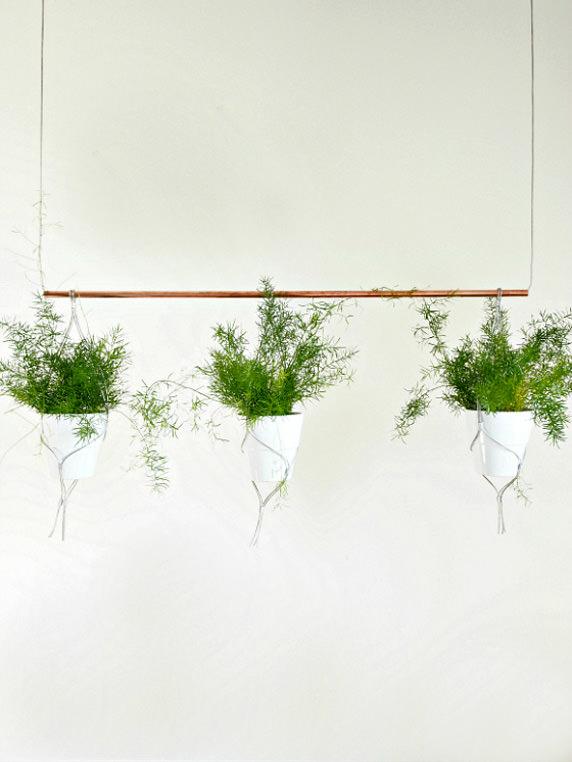
For the “cute” in all of us… these polka dot teacups were converted by gluing the saucers to the cups with industrial strength glue (we recommend Gorilla Glue) and using a ceramic tile bit and an drill to create holes for hanging.
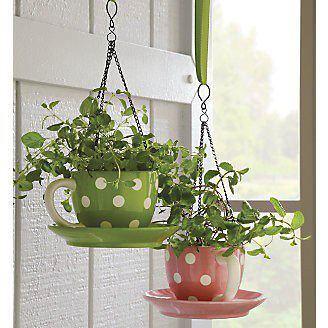
Old light fixtures and that same tile bit and drill create these great planters by Lark Books.
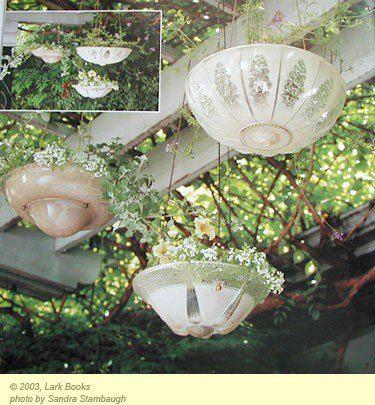
This project both recycles, which makes is cool modern, and uses a touch of the past. Love it’s originality. Find the DIY instructions here.
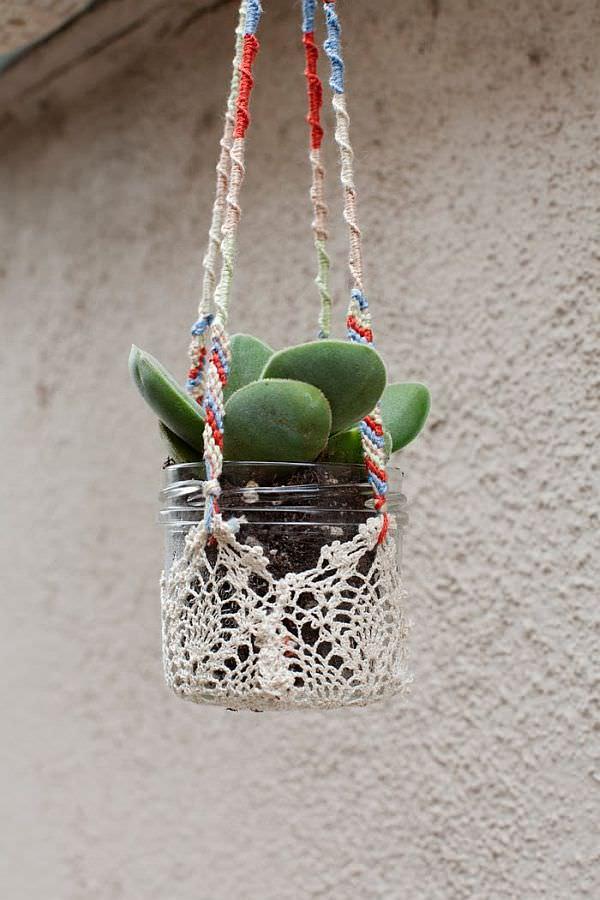
One of my favorites in this post is the DIY mason jar planters! Oh So Very Pretty has the complete instructions. See more mason jar ideas from us here.
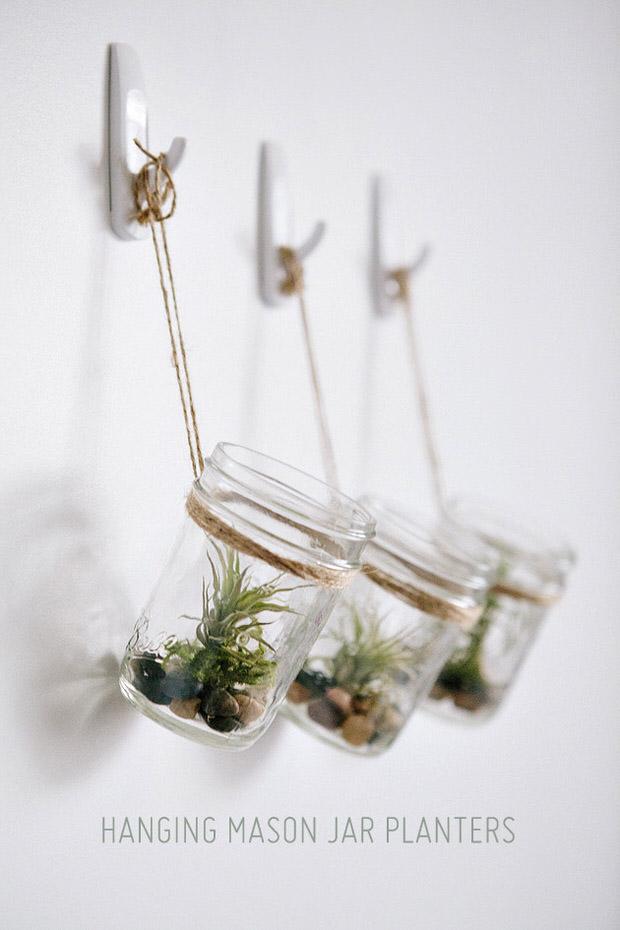
So create some hanging planters for your garden! Don’t feel like you have to limit them to the front porch though. Hang them in trees, off brackets on fence posts, or from the top of arbors and decks. Let us know, which one is your favorite?
1
0
文章
小马奥
2017年05月23日

Learn about the Best Plants For Hanging Baskets. Hanging baskets filled with colorful flowers and plants are very showy and elegant and adorn any garden. You don’t need a lot of space to display them, too!A variety of flowers and plants can be grown in hanging baskets. The choice of plants in baskets depends on both the size of the basket and the growing conditions where the basket has to be placed. The baskets, which are kept in the shade and less windy space are easier to look after as they require less watering.Nasturtium

If you are looking for a quick growing and low maintenance plant, nasturtium is the plant you should consider. The trailing varieties of nasturtium work especially well and it is one of best plants for hanging baskets. Nasturtium loves the warmth and sun, though they can tolerate partial shade. They prefer poor soil and doesn’t need much fertilizer.
Petunia

Petunia is one of the most popular flowers and best plant for hanging the basket. It covers hanging basket quickly and blooms profusely. There are many varieties of petunias that come in myriads of colors including black.
Tomatoes

Growing tomatoes (cherry tomatoes) in hanging baskets is an apt way to use vertical space, plus they adapt easily unlike other vegetables. Basically, your success in growing tomatoes depends on three factors— yours choosing right variety, basket, and providing it appropriate conditions, if you satisfy all of the three, you’ll get rich homegrown tomatoes in harvesting season. Learn how to grow tomatoes in a hanging basket.
Also Read: How to Grow Tomatoes on a Balcony
Portulaca

Portulaca or moss rose is an excellent trailing ground cover plant, not only the colorful flowers, its needle-like succulent foliage looks wonderful too. This tropical beauty can be grown as an annual plant in non-tropical places and as a perennial in tropics in both containers and hanging baskets.
Begonia

Begonias are the perfect plant for shady places. It blooms continuously in summer and fall and in shades of pink, red and white. The best Begonias for hanging baskets are trailing varieties. Begonias require moist soil, however, you shouldn’t not over water begonias, as the plant is susceptible to root rot.
Philodendron and Spider Plant

Both the spider plant and species of philodendron are considered as houseplants, but they can also be grown outdoors in protected conditions. They do better when grown alone in a hanging planter. Spider plant forms a rosette or grouping of the bush like light green and white variegated foliage.
Philodendrons have solidly light green or variegated, waxy, heart-shaped leaves and have a vine like growing habit. They require indirect sunlight and grow well in the shade outdoors or in low light, indoors.
Diascia

Diascia is another hanging basket plant that you can grow. This short-lived perennial is often grown as an annual, it is hardy in warmer zones (USDA Zones 9-11), however, some varieties are hardy down to Zone 7. Its beautiful colorful flowers are rather small, of bright colors and appear in clusters from spring to fall.
Geranium

The Geranium is another plant that can be grown in baskets. Both the foliage and flowers are beautiful. Geraniums prefer a sunny spot and well-draining soil to flower.
Verbena

It is possible to grow verbena in a hanging basket, this sun-loving plant is suitable for South facing places. Verbenas come in a variety of colors and shades including pink, purple, white, red and lavender etc. The cluster of flowers blooms continuously throughout the summer in a cold climate. Whereas, in tropics verbenas are perennial.
Fuchsia

Fuchsia is an elegant and colorful flowering hanging basket plant that prefers shade and cool summers. Flowers from over 120 varieties of fuchsia plants can grow to a length of 4 inches. The trailing stems cascade out over the hanging basket with a mass of colorful flowers. Fuchsia flowers are often deep pink or orange with purple or white vibrant trimmings.
Impatiens

The impatiens grow best in shade space and in moist soil. It comes in a variety of colors including salmon, cherry, pink, white and lavender. If growing in baskets, apply a balanced fertilizer in every two to three weeks. Impatiens grow very easily from seed and cuttings.
Dianthus

Dianthus comes in over 300 varieties and usually grown as an annual. This well-known flower is good for borders, ground covers, for cut flowers and several species are compact enough for planting in the hanging baskets, offering a profusion of flowers during the summer.
Ivy

Evergreen, perennial plant, ivy comes with a variety of leaf shapes and variegated foliage types. It is a perfect plant that provides a background for the gaudiest colors. It trails gracefully in hanging baskets. Most ivy varieties thrive inside the home, as they do not require direct sunlight and only need minimal care. However, it grows outside easily in shade.
Pansy

Pansies are a fast growing plant that provides masses of beautiful flowers during the summer in many shades. Deadhead them to extend bloom time.
Lobelia

One of the best flowers that grows easily in containers. Popular for the colors. The leaves are small, smooth, shiny and tiny flowers appear in blue, purple, pink or white. It blooms all summer long. Abundant and long flowering is promoted by regular trimming of withered shoots.
Sweet Alyssum

Sitting near a sweet alyssum hanging basket is a joy. This amazing fragrant flower is perfect for balcony and roof top gardens. The trailing habit makes it is a perfect plant for hanging baskets.
Lantana

Small weeping varieties are more suitable for hanging baskets shrubby ones. The lantana flowers are fragrant, colorful, pleasing, attract pollinators but invasive perennial in warm frost free areas. But in hanging baskets or in pots they are controllable. You can also grow lantana in colder regions as an annual.
Also Read: How to Grow Lantana
Calibrachoa

Also called “Million Bells”, this beautiful cousin of petunia is more suitable for hanging baskets than petunias and more durable to changing weather conditions and diseases. It can grow up to 8 inches tall. The plant produces blooms all summer long and in fall in moderate climates until the first frost. Whereas in tropics, it blooms in winter and spring.
Also Read: Calibrachoa Care
Nemesia

Nemesia is one of the easiest annuals that you can grow in both pots and in hanging baskets. It is a hardy perennial in USDA Zones 9-10. Its flowers are double-lipped with a spur in small pansy-like appearance and lobelia-like size.

If you are looking for a quick growing and low maintenance plant, nasturtium is the plant you should consider. The trailing varieties of nasturtium work especially well and it is one of best plants for hanging baskets. Nasturtium loves the warmth and sun, though they can tolerate partial shade. They prefer poor soil and doesn’t need much fertilizer.
Petunia

Petunia is one of the most popular flowers and best plant for hanging the basket. It covers hanging basket quickly and blooms profusely. There are many varieties of petunias that come in myriads of colors including black.
Tomatoes

Growing tomatoes (cherry tomatoes) in hanging baskets is an apt way to use vertical space, plus they adapt easily unlike other vegetables. Basically, your success in growing tomatoes depends on three factors— yours choosing right variety, basket, and providing it appropriate conditions, if you satisfy all of the three, you’ll get rich homegrown tomatoes in harvesting season. Learn how to grow tomatoes in a hanging basket.
Also Read: How to Grow Tomatoes on a Balcony
Portulaca

Portulaca or moss rose is an excellent trailing ground cover plant, not only the colorful flowers, its needle-like succulent foliage looks wonderful too. This tropical beauty can be grown as an annual plant in non-tropical places and as a perennial in tropics in both containers and hanging baskets.
Begonia

Begonias are the perfect plant for shady places. It blooms continuously in summer and fall and in shades of pink, red and white. The best Begonias for hanging baskets are trailing varieties. Begonias require moist soil, however, you shouldn’t not over water begonias, as the plant is susceptible to root rot.
Philodendron and Spider Plant

Both the spider plant and species of philodendron are considered as houseplants, but they can also be grown outdoors in protected conditions. They do better when grown alone in a hanging planter. Spider plant forms a rosette or grouping of the bush like light green and white variegated foliage.
Philodendrons have solidly light green or variegated, waxy, heart-shaped leaves and have a vine like growing habit. They require indirect sunlight and grow well in the shade outdoors or in low light, indoors.
Diascia

Diascia is another hanging basket plant that you can grow. This short-lived perennial is often grown as an annual, it is hardy in warmer zones (USDA Zones 9-11), however, some varieties are hardy down to Zone 7. Its beautiful colorful flowers are rather small, of bright colors and appear in clusters from spring to fall.
Geranium

The Geranium is another plant that can be grown in baskets. Both the foliage and flowers are beautiful. Geraniums prefer a sunny spot and well-draining soil to flower.
Verbena

It is possible to grow verbena in a hanging basket, this sun-loving plant is suitable for South facing places. Verbenas come in a variety of colors and shades including pink, purple, white, red and lavender etc. The cluster of flowers blooms continuously throughout the summer in a cold climate. Whereas, in tropics verbenas are perennial.
Fuchsia

Fuchsia is an elegant and colorful flowering hanging basket plant that prefers shade and cool summers. Flowers from over 120 varieties of fuchsia plants can grow to a length of 4 inches. The trailing stems cascade out over the hanging basket with a mass of colorful flowers. Fuchsia flowers are often deep pink or orange with purple or white vibrant trimmings.
Impatiens

The impatiens grow best in shade space and in moist soil. It comes in a variety of colors including salmon, cherry, pink, white and lavender. If growing in baskets, apply a balanced fertilizer in every two to three weeks. Impatiens grow very easily from seed and cuttings.
Dianthus

Dianthus comes in over 300 varieties and usually grown as an annual. This well-known flower is good for borders, ground covers, for cut flowers and several species are compact enough for planting in the hanging baskets, offering a profusion of flowers during the summer.
Ivy

Evergreen, perennial plant, ivy comes with a variety of leaf shapes and variegated foliage types. It is a perfect plant that provides a background for the gaudiest colors. It trails gracefully in hanging baskets. Most ivy varieties thrive inside the home, as they do not require direct sunlight and only need minimal care. However, it grows outside easily in shade.
Pansy

Pansies are a fast growing plant that provides masses of beautiful flowers during the summer in many shades. Deadhead them to extend bloom time.
Lobelia

One of the best flowers that grows easily in containers. Popular for the colors. The leaves are small, smooth, shiny and tiny flowers appear in blue, purple, pink or white. It blooms all summer long. Abundant and long flowering is promoted by regular trimming of withered shoots.
Sweet Alyssum

Sitting near a sweet alyssum hanging basket is a joy. This amazing fragrant flower is perfect for balcony and roof top gardens. The trailing habit makes it is a perfect plant for hanging baskets.
Lantana

Small weeping varieties are more suitable for hanging baskets shrubby ones. The lantana flowers are fragrant, colorful, pleasing, attract pollinators but invasive perennial in warm frost free areas. But in hanging baskets or in pots they are controllable. You can also grow lantana in colder regions as an annual.
Also Read: How to Grow Lantana
Calibrachoa

Also called “Million Bells”, this beautiful cousin of petunia is more suitable for hanging baskets than petunias and more durable to changing weather conditions and diseases. It can grow up to 8 inches tall. The plant produces blooms all summer long and in fall in moderate climates until the first frost. Whereas in tropics, it blooms in winter and spring.
Also Read: Calibrachoa Care
Nemesia

Nemesia is one of the easiest annuals that you can grow in both pots and in hanging baskets. It is a hardy perennial in USDA Zones 9-10. Its flowers are double-lipped with a spur in small pansy-like appearance and lobelia-like size.
0
1
文章
小马奥
2017年05月23日

If you’re looking for some OFFBEAT ideas for growing plants indoors or outdoors, these DIY hanging planter ideas are worth looking at!To give your garden a playful look, you need to be creative and what’s better than some offbeat planters made from unused home items hanging in line and beautiful plants trailing from them.1. DIY Hanging Terrarium

The DIY hanging terrarium planter is perfect for keeping indoors, and it looks awesome. With a few supplies and plants, you can do this without any difficulty following the steps. Visit this website and this ONE too, to learn everything.
2. DIY Birdcage Planter

Add a little whim to your garden by adding a birdcage planter. You can also hang it on your balcony. The step by step article is available here!
3. Hanging Purse Garden

Repurpose old and damaged purses into a beautiful hanging garden. Keep the plants in their pots so you can easily slip them out to drain excess moisture. You can also line the purse with plastic to keep the purse from getting wet.
4. Hanging Seashell Planter

You’ll need some big conch shells, threads to tie, soil, trailing succulents or you can also use air plants. See more INCREDIBLE SEASHELL planter ideas here!
5. DIY Mason Jar Hanging Planter

The Mason jars are so versatile; we also added a few ideas here! This DIY mason jar planter is not hanging but actually clamped, a wonderful idea. We found it on Allison Patrick’s blog. Here’s an another link to a different DIY post!
6. Hanging Hat Planter

If you have a few old hats, use them for this bizarre idea. Hang your planters from a wall, cut a hole into the top of the hat of the size of plant stems. Now slide the stems out through the hole so that it’ll look like plants are growing in hats, your planter is ready. Allow a few days for plants to grow around the hat to see the natural display.
7. Hanging Plastic Bottle Planter

Simple idea for upcycling old plastic bottles and turn them into beautiful hanging plant pots. Check out the tutorial here.
8. Creative Hanging Planter

We found this DIY tutorial on Bloglovin and loved it. Although the tutorial is not available in English, you can translate it using Google translate.
9. DIY Hanging Air Plant Holder

Impressive DIY for indoors. This unique plant holder is cool to display air plants. The step by step tutorial is available on Squirrelly Minds.
10. Tin Can Hanging Planter

If you have tin cans in your homes that you’re about to throw, make use of them to grow annuals, succulents or herbs and hang them. So many DIY tutorials available if you search the web. One of its kind is here!
11. Hanging Gloves Planters

If you love to surprise your visitors, this idea is for you. Just plant the plants in small pots and place them in gloves. Hang the gloves on a wall, on a tree or a rope.
12. DIY Hanging Planters Out of Metal Bowls

These hanging planters are so unique and made of metal bowls. It’s a sexy idea, to learn step by step– Visit A Beautiful Mess
13. Ice Cream Cone DIY Hanging Planter

A fun DIY hanging planter idea for Ice cream lovers. You can make a planter like this for under 10$. The complete tutorial is available on Brit.co.
14. Hanging Tire Planter

Old Tire Uses in the garden are popular, and one of the best ways to use an old tire in the garden is to make it a hanging tire planter. See the DIY tutorial here!
15. DIY Plastic Bottle Hanging Planter

If you love recycling projects, take a look at this DIY at PopSugar! You can also look at 13 Plastic Bottle Recycling Ideas here.
16. Hanging Tray Planter

Make this easy hanging succulent planter with a tray or shallow pot, succulents, threads, and candles. To make it, just plant the succulents in a tray that has holes on sides to hang (or drill a few holes). Hang the tray with the help of threads. You can also put some candles, burn those candles in the night to create an astonishing effect. Ensure you do not hang this in a windy spot.

The DIY hanging terrarium planter is perfect for keeping indoors, and it looks awesome. With a few supplies and plants, you can do this without any difficulty following the steps. Visit this website and this ONE too, to learn everything.
2. DIY Birdcage Planter

Add a little whim to your garden by adding a birdcage planter. You can also hang it on your balcony. The step by step article is available here!
3. Hanging Purse Garden

Repurpose old and damaged purses into a beautiful hanging garden. Keep the plants in their pots so you can easily slip them out to drain excess moisture. You can also line the purse with plastic to keep the purse from getting wet.
4. Hanging Seashell Planter

You’ll need some big conch shells, threads to tie, soil, trailing succulents or you can also use air plants. See more INCREDIBLE SEASHELL planter ideas here!
5. DIY Mason Jar Hanging Planter

The Mason jars are so versatile; we also added a few ideas here! This DIY mason jar planter is not hanging but actually clamped, a wonderful idea. We found it on Allison Patrick’s blog. Here’s an another link to a different DIY post!
6. Hanging Hat Planter

If you have a few old hats, use them for this bizarre idea. Hang your planters from a wall, cut a hole into the top of the hat of the size of plant stems. Now slide the stems out through the hole so that it’ll look like plants are growing in hats, your planter is ready. Allow a few days for plants to grow around the hat to see the natural display.
7. Hanging Plastic Bottle Planter

Simple idea for upcycling old plastic bottles and turn them into beautiful hanging plant pots. Check out the tutorial here.
8. Creative Hanging Planter

We found this DIY tutorial on Bloglovin and loved it. Although the tutorial is not available in English, you can translate it using Google translate.
9. DIY Hanging Air Plant Holder

Impressive DIY for indoors. This unique plant holder is cool to display air plants. The step by step tutorial is available on Squirrelly Minds.
10. Tin Can Hanging Planter

If you have tin cans in your homes that you’re about to throw, make use of them to grow annuals, succulents or herbs and hang them. So many DIY tutorials available if you search the web. One of its kind is here!
11. Hanging Gloves Planters

If you love to surprise your visitors, this idea is for you. Just plant the plants in small pots and place them in gloves. Hang the gloves on a wall, on a tree or a rope.
12. DIY Hanging Planters Out of Metal Bowls

These hanging planters are so unique and made of metal bowls. It’s a sexy idea, to learn step by step– Visit A Beautiful Mess
13. Ice Cream Cone DIY Hanging Planter

A fun DIY hanging planter idea for Ice cream lovers. You can make a planter like this for under 10$. The complete tutorial is available on Brit.co.
14. Hanging Tire Planter

Old Tire Uses in the garden are popular, and one of the best ways to use an old tire in the garden is to make it a hanging tire planter. See the DIY tutorial here!
15. DIY Plastic Bottle Hanging Planter

If you love recycling projects, take a look at this DIY at PopSugar! You can also look at 13 Plastic Bottle Recycling Ideas here.
16. Hanging Tray Planter

Make this easy hanging succulent planter with a tray or shallow pot, succulents, threads, and candles. To make it, just plant the succulents in a tray that has holes on sides to hang (or drill a few holes). Hang the tray with the help of threads. You can also put some candles, burn those candles in the night to create an astonishing effect. Ensure you do not hang this in a windy spot.
1
1
文章
扭扭
2017年05月23日

Learn growing tomatoes in hanging basket if you have a balcony garden, this way they’ll not take much space.

Tomatoes require lot of space to grow and if you have a small garden, growing them in hanging basket is an apt way to use vertical space, plus they adapt easily unlike other vegetables.
Juicy, plump, small, big, round and colorful tomatoes are one of the most favorite crops, whether you have a garden or not you can grow them in hanging baskets.
Growing Tomatoes in Hanging Baskets
Your success in growing tomatoes depends on three factors— yours choosing right variety, basket and providing it appropriate conditions, if you satisfy all of the three, you’ll get rich home grown tomatoes in harvesting season.
Choosing Right Tomato Variety
You can’t grow regular tomato plants. Varieties of cherry tomatoes do well in hanging baskets— ‘hundreds and thousands’ (UK variety) is highly productive and its mini tomatoes taste great, plant grows bush like and spread well. Other varieties like Tumbling Tom (both red and yellow) provides classic tomato taste and most recommended, whereas deep red Maskotka gives juicy flavor and fruit heavily.
Choosing a Basket
Take a *deep basket of diameter 12” as these varieties don’t need bigger pots. Line your basket with plastic or coconut fiber liners. However, it’s better to line it with plastic. For this, make some drainage holes in plastic and place it inside the basket, make sure to spread it properly. As hanging baskets dry out quickly, lining them helps to keep the moisture in soil.
Check out this self watering hanging basket on amazon. Its unique wick system draws the moisture up into the soil, allowing the plant to feed at its’ own rate. The best thing is, it is of only $14.7.

Tomatoes require lot of space to grow and if you have a small garden, growing them in hanging basket is an apt way to use vertical space, plus they adapt easily unlike other vegetables.
Juicy, plump, small, big, round and colorful tomatoes are one of the most favorite crops, whether you have a garden or not you can grow them in hanging baskets.
Growing Tomatoes in Hanging Baskets
Your success in growing tomatoes depends on three factors— yours choosing right variety, basket and providing it appropriate conditions, if you satisfy all of the three, you’ll get rich home grown tomatoes in harvesting season.
Choosing Right Tomato Variety
You can’t grow regular tomato plants. Varieties of cherry tomatoes do well in hanging baskets— ‘hundreds and thousands’ (UK variety) is highly productive and its mini tomatoes taste great, plant grows bush like and spread well. Other varieties like Tumbling Tom (both red and yellow) provides classic tomato taste and most recommended, whereas deep red Maskotka gives juicy flavor and fruit heavily.
Choosing a Basket
Take a *deep basket of diameter 12” as these varieties don’t need bigger pots. Line your basket with plastic or coconut fiber liners. However, it’s better to line it with plastic. For this, make some drainage holes in plastic and place it inside the basket, make sure to spread it properly. As hanging baskets dry out quickly, lining them helps to keep the moisture in soil.
Check out this self watering hanging basket on amazon. Its unique wick system draws the moisture up into the soil, allowing the plant to feed at its’ own rate. The best thing is, it is of only $14.7.
1
0
文章
Gina
2017年03月15日

If you need more gardening space, or you just want to try something a little more unique and interesting, consider a vertical garden. There is nothing new about the idea of going up in garden design… hanging planters, trees and arbors and porticos are all examples of taking things skyward. But these DIY vertical gardens are clever and smart, and give your garden a creative edge. So the next time you’re trying to figure out how to find enough space to grow those herbs, or what you can do to liven up a ho-hum garden space, go vertical! Our feature photo below, is a modern, space saving DIY vertical garden from Chris at ‘Man Made DIY’. He grew veggies in it, but anything is fair game!

Rachel at ‘Shades of Blue Interiors’ wanted a pop of color for her small front porch. Her DIY ladder vertical garden brought that color to eye level and added charm to her porch as well! This is an easy project with inexpensive materials. The key would be an attractive wooden ladder! If you don’t have an authentically old one, consider picking up a cheap wood ladder at a home improvement store and staining it.
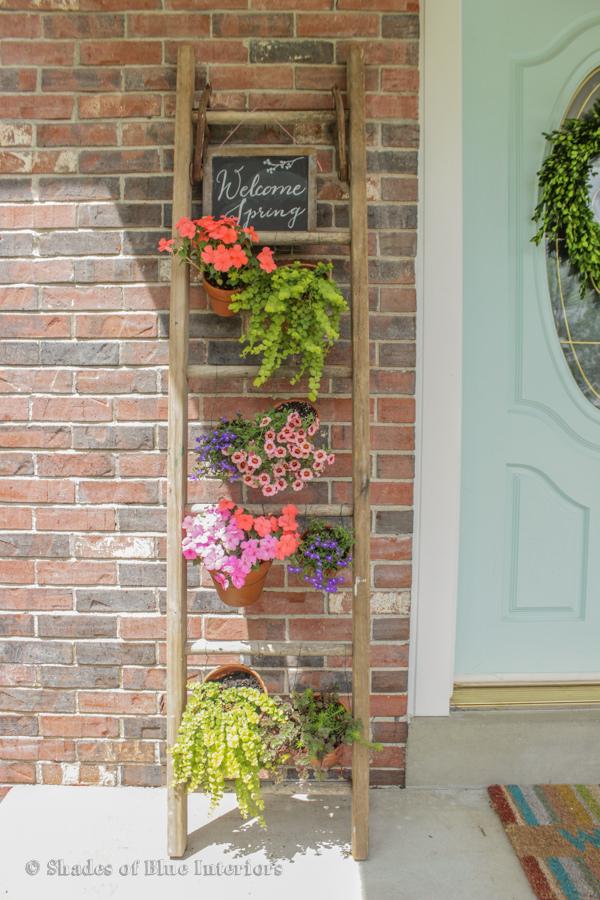
Got a roll of rusty metal fence? Or already have a fence that could use a spruce up? Punch holes in simple metal or plastic containers, and hang onto the fence with an s-hook. Plant with your fav flowers or herbs! Remember, keep the containers small enough so that the fence will hold the weight when they are full of soil. This project is from Jill at ‘Sew a Fine Seam‘.
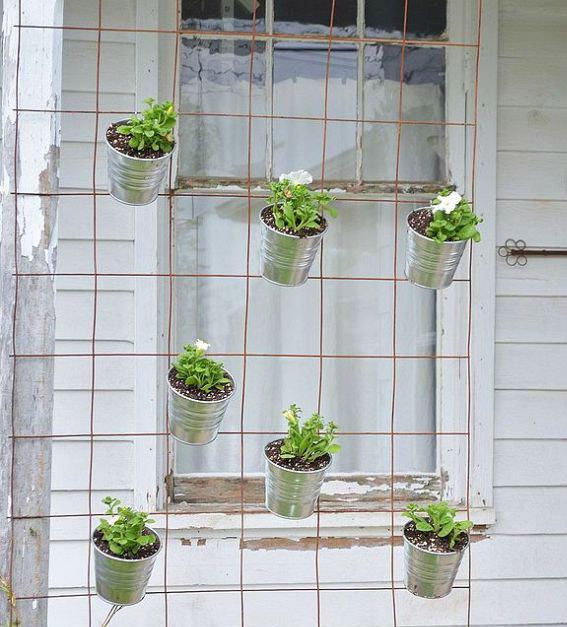
Make succulent frames with this tutorial from ‘Sunset‘. This is a fun project that can turn a patio or balcony space into a really special garden area, even if you have only concrete flooring! Photo from ‘Sky Parlour‘.

‘AKA Design’ built an arbor support for their DIY vertical garden. I love these kinds of container gardens because they are so versatile. This could be all moss, ferns, succulents, herbs, or flowers. Use a color theme or all the colors you can. Trailing plants or mounding ones. Having the same pot throughout ties it all together. Great tutorial!

This vertical herb garden trellis wall from Carrie at ‘Making Lemonade’ is perfect for adding some shade to a window with none, or just making fresh herbs easily accessible from the kitchen door! Simple project anyone can do with ordinary trellis from the home improvement store and some Ikea pots. Plus, I love her theory on how important it is to take care of yourself! (Go read it, the whole deck makeover is so cute!)
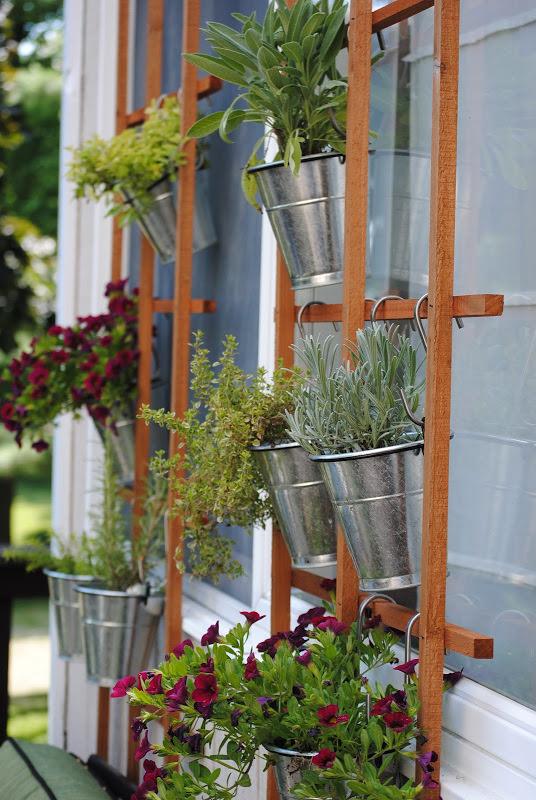
Love this DIY suspended vertical garden from ‘The Heathered Nest’ via ‘Remodelaholic’. This project is made with some simple pots and galvanized wire, and they walk you through it step by step. They even make suggestions on how you can customize it!
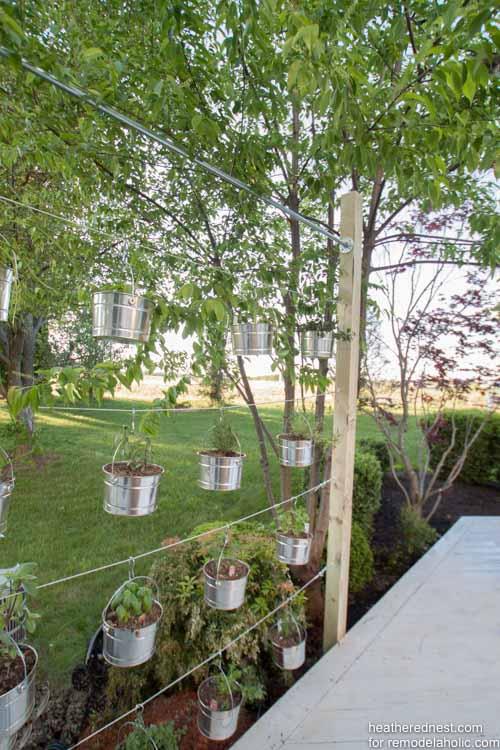
This DIY outdoor succulent wall garden from ‘Sugar & Cloth’ was made using an unfinished hand rail and used paint tins! Love how clever this is.

Lovin’ on this DIY simple modern vertical wall garden from ‘The Fresh Exchange’. Would love to grow container veggies in this! This is made with felt from the fabric store, believe it or not!
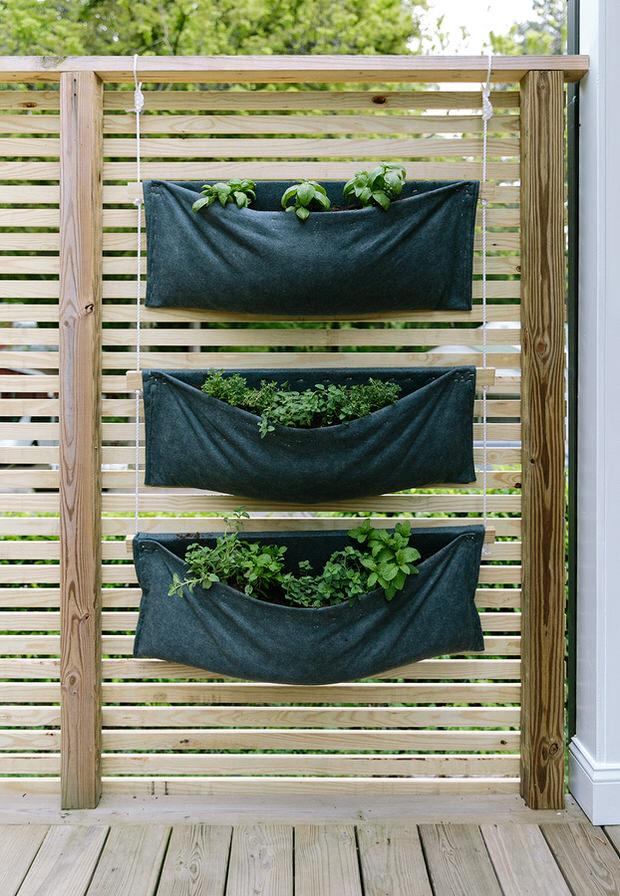
This vertical garden DIY is from ‘Numi Tea Blog’, and is made from ordinary rain gutters. I wonder if we could figure out a way to mount these to a stone block wall? :)
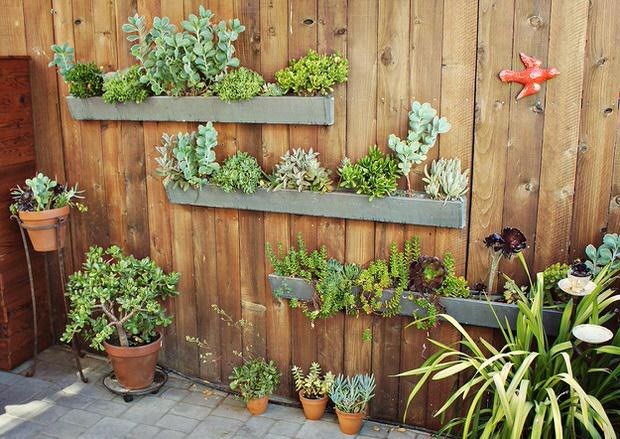
Make a cinderblock garden! You can visit our tutorial for our DIY cinder clock vertical planter to get all the instructions. This photo from ‘The Rainforest Garden‘.

Last, learn how to plant a vertical garden from ‘Front & Main’, the blog of ‘West Elm’. This project would look amazing indoors or out on a covered patio. Simple and awesome!
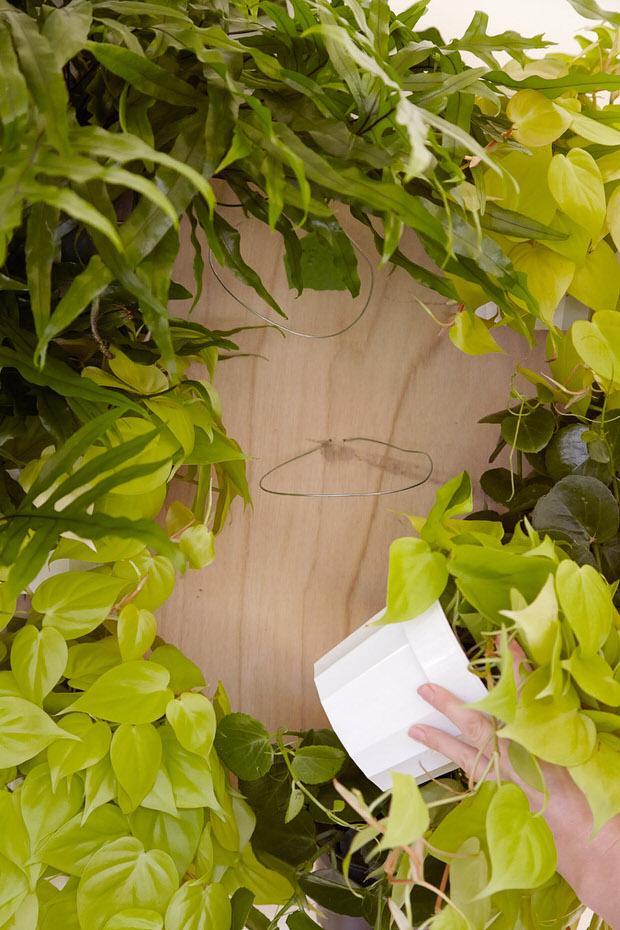

Get creative! No matter how small or boring your garden space, there is always a way to create your own amazing little bit of green earth!

Rachel at ‘Shades of Blue Interiors’ wanted a pop of color for her small front porch. Her DIY ladder vertical garden brought that color to eye level and added charm to her porch as well! This is an easy project with inexpensive materials. The key would be an attractive wooden ladder! If you don’t have an authentically old one, consider picking up a cheap wood ladder at a home improvement store and staining it.

Got a roll of rusty metal fence? Or already have a fence that could use a spruce up? Punch holes in simple metal or plastic containers, and hang onto the fence with an s-hook. Plant with your fav flowers or herbs! Remember, keep the containers small enough so that the fence will hold the weight when they are full of soil. This project is from Jill at ‘Sew a Fine Seam‘.

Make succulent frames with this tutorial from ‘Sunset‘. This is a fun project that can turn a patio or balcony space into a really special garden area, even if you have only concrete flooring! Photo from ‘Sky Parlour‘.

‘AKA Design’ built an arbor support for their DIY vertical garden. I love these kinds of container gardens because they are so versatile. This could be all moss, ferns, succulents, herbs, or flowers. Use a color theme or all the colors you can. Trailing plants or mounding ones. Having the same pot throughout ties it all together. Great tutorial!

This vertical herb garden trellis wall from Carrie at ‘Making Lemonade’ is perfect for adding some shade to a window with none, or just making fresh herbs easily accessible from the kitchen door! Simple project anyone can do with ordinary trellis from the home improvement store and some Ikea pots. Plus, I love her theory on how important it is to take care of yourself! (Go read it, the whole deck makeover is so cute!)

Love this DIY suspended vertical garden from ‘The Heathered Nest’ via ‘Remodelaholic’. This project is made with some simple pots and galvanized wire, and they walk you through it step by step. They even make suggestions on how you can customize it!

This DIY outdoor succulent wall garden from ‘Sugar & Cloth’ was made using an unfinished hand rail and used paint tins! Love how clever this is.

Lovin’ on this DIY simple modern vertical wall garden from ‘The Fresh Exchange’. Would love to grow container veggies in this! This is made with felt from the fabric store, believe it or not!

This vertical garden DIY is from ‘Numi Tea Blog’, and is made from ordinary rain gutters. I wonder if we could figure out a way to mount these to a stone block wall? :)

Make a cinderblock garden! You can visit our tutorial for our DIY cinder clock vertical planter to get all the instructions. This photo from ‘The Rainforest Garden‘.

Last, learn how to plant a vertical garden from ‘Front & Main’, the blog of ‘West Elm’. This project would look amazing indoors or out on a covered patio. Simple and awesome!


Get creative! No matter how small or boring your garden space, there is always a way to create your own amazing little bit of green earth!
1
1
文章
Joss
2017年02月20日

A big pot of red zonal geraniums is an eye-popping spot of color. Two pots next to the mailbox is a friendly welcome! These versatile plants are ideal for window boxes, hanging baskets, wheelbarrows, plumbing fixtures, you name it. They are also excellent performers in memorial boxes.
It seems that 45 percent of all geraniums sold are red (and there are hundreds of shades of red). After that, 30 percent are salmon, 15 percent pink, and 10 percent white. That doesn’t leave out the gorgeous lavenders and yellows that are available.

And, have you seen the ivy variety? They have funky saw-toothed leaves and sweet, fuzzy flowers with all the hardy features of the regular kind.
Here are a few “frequently asked questions” on geraniums and their care.
Why are they called “zonal” geraniums?
During cooler weather, red rings often appear on the leaves. These are referred to as “zones” and add a bright touch to the foliage.
Is it better to grow geraniums from #seed or to buy started plants?
Cutting-grown plants are healthier and hardier, and start to bloom sooner than those grown from seed. They stay truer to the mother’s variety, too, so there are fewer variations in flower color and quality. Always buy started plants from a reputable grower and you will experience great success.
Should I pinch or deadhead my geraniums?
You absolutely should pinch and deadhead your geraniums. Pinching promotes bushiness, and deadheading encourages new growth for new blooms. Pinch off approximately 1 inch of the stem (or more for leggy plants) once they’re established in their new homes. When blooms start to fade and shed petals, pinch flower stems close to the branch. It should re-bloom in a few days.

How often do I need to water?
Geraniums like moist soil so check often and water thoroughly when they’re dry. They can take being too wet or too dry for a while, but they don’t like it! When you water, pour the water into the pot underneath the bottom leaves, rather than pouring it over the top. Your blooms will last longer and be prettier.
Should I feed my geraniums?
You bet you should feed geraniums. Water with a solution of MiracleGro or other standard fertilizer once a week. Follow the label directions to get just the right amount.
Why do the bottom leaves turn yellow?
You’re either under- or over-watering. Check the soil and the pot. Make sure it’s draining properly. Geraniums are full-sun plants, but they should not dry out during the hot days of summer. Just pinch off the yellow leaves and keep a close eye on your plants, and you’ll be fine.

Can I keep my geraniums over the winter?
You can try. When the weather cools off down to mid- to high forties at night, repot in fresh potting mix, give them a dose of fertilizer, and set them in a sunny, southern-exposure window. (They probably won’t make it through the winter without a southern exposure.) Water when dry, and drop back on fertilizer, only feeding every few weeks. Keep your fingers crossed, and try not to be too disappointed if they give up in January.
Above all, enjoy your geraniums. You’re carrying on a long tradition by growing these beautiful plants.
It seems that 45 percent of all geraniums sold are red (and there are hundreds of shades of red). After that, 30 percent are salmon, 15 percent pink, and 10 percent white. That doesn’t leave out the gorgeous lavenders and yellows that are available.

And, have you seen the ivy variety? They have funky saw-toothed leaves and sweet, fuzzy flowers with all the hardy features of the regular kind.
Here are a few “frequently asked questions” on geraniums and their care.
Why are they called “zonal” geraniums?
During cooler weather, red rings often appear on the leaves. These are referred to as “zones” and add a bright touch to the foliage.
Is it better to grow geraniums from #seed or to buy started plants?
Cutting-grown plants are healthier and hardier, and start to bloom sooner than those grown from seed. They stay truer to the mother’s variety, too, so there are fewer variations in flower color and quality. Always buy started plants from a reputable grower and you will experience great success.
Should I pinch or deadhead my geraniums?
You absolutely should pinch and deadhead your geraniums. Pinching promotes bushiness, and deadheading encourages new growth for new blooms. Pinch off approximately 1 inch of the stem (or more for leggy plants) once they’re established in their new homes. When blooms start to fade and shed petals, pinch flower stems close to the branch. It should re-bloom in a few days.

How often do I need to water?
Geraniums like moist soil so check often and water thoroughly when they’re dry. They can take being too wet or too dry for a while, but they don’t like it! When you water, pour the water into the pot underneath the bottom leaves, rather than pouring it over the top. Your blooms will last longer and be prettier.
Should I feed my geraniums?
You bet you should feed geraniums. Water with a solution of MiracleGro or other standard fertilizer once a week. Follow the label directions to get just the right amount.
Why do the bottom leaves turn yellow?
You’re either under- or over-watering. Check the soil and the pot. Make sure it’s draining properly. Geraniums are full-sun plants, but they should not dry out during the hot days of summer. Just pinch off the yellow leaves and keep a close eye on your plants, and you’ll be fine.

Can I keep my geraniums over the winter?
You can try. When the weather cools off down to mid- to high forties at night, repot in fresh potting mix, give them a dose of fertilizer, and set them in a sunny, southern-exposure window. (They probably won’t make it through the winter without a southern exposure.) Water when dry, and drop back on fertilizer, only feeding every few weeks. Keep your fingers crossed, and try not to be too disappointed if they give up in January.
Above all, enjoy your geraniums. You’re carrying on a long tradition by growing these beautiful plants.
0
0
文章
Abigal
2017年02月16日


I love the idea of a hanging bed within the garden! I can’t think of another DIY project that would be more appreciated or well used! Especially as the long days of summer come upon us, laying out on a comfie “bed” while enjoying the weather, nature and the scent and sight of my garden seems like Heaven. Oh, and a good book too! Here are a couple of great tutorials on building a hanging bed or swing bed. It’s easier than it looks, basically just requiring a sturdy overhanging support, a frame, some chain or rope…and a comfie mattress or pad and pillows! This could make a great front porch project as well.
DIY Pallet Swing Bed
We really like the Pallet Swing Bed over at The Merry Thought. They have a nice simple tutorial there.

DIY Hanging Bed
A little more difficult is this DIY project by the folks at Home Depot. Great detailed instructions for anyone ready to tackle this!


Will anyone do this DIY project? Please help me, thank you!
0
0
Succulent Hauz
2017年01月02日
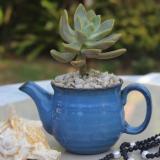
Can anyone help me name this Huernia? It doesn't stand at all lookes like a hanging one.
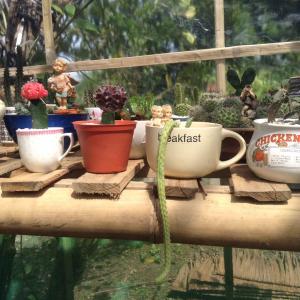

3
0
stone:@Succulent Hauz Similar to Selenicereus innesii.
Succulent Hauz:@Andy yeah but it doesnt have hairs like that
Andy:Similar to Aporocactus flagelliformis (L.) Lem
求助
beautyhouse
2016年06月23日

#SOS I received a hanging basket of Million Bells as a gift, and I've no clue how to groom them.
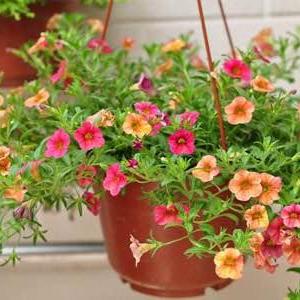

2
0
beautyhouse:@Andrea thax for your answer andrea but I have adopted the other answer ,what's a pity
Andrea:Check the foliage regularly for aphids and thrips, tiny insects that sometimes feed on Million Bells' leaf sap. Flat, pear-shaped aphids colonize stems and leaf undersides. The yellow, red, brown, black or green pests secrete a clear, sticky waste called honeydew. Fringed-winged, white, yellow or black thrips hide in buds and furled leaves. A strong spray of water blasts the pests from the plants.
Mirella:Give Million Bells a liquid, 20-10-20 fertilizer formulated for acid-loving plants.



